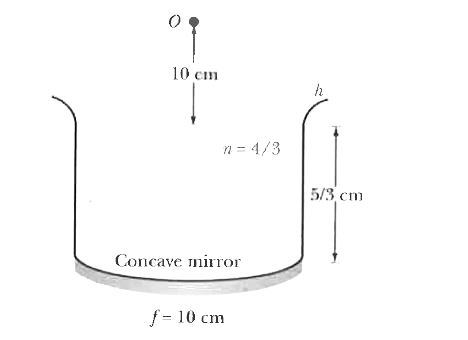Apparent distance of the image formed by a concave mirror dipped in water
Find the location of the final image of O formed by the system (Fig. 34-8). Assume that O is on the principal axis of the concave mirror.
Text Solution
(1) Here, the image is formed after three events : refraction from water, reflection from mirror, and again refraction from water.
(2) As we discussed in Chapter 33, image of one event will act as an object for the next event. Thus, first event we consider is refraction from water for which we can apply fromula for apparent depth. Then next event will be reflection from concave mirror. The next event would be again refraction from water surface which will be the last event.
Calculation : when the mirror sees the object O, it does not appear to be at 10cm from the water surface. Rather, its apparent distance is
dappnreflected=dactnincident
dapp=10×43=403cm from water surface
The image formed by this refraction will act as an object for the next surface (mirror) :
u=−(403+53)=−15cm
Note that focal length of mirror (r/2) does not depend on the refractive index of surrounding medium. The image distance is given by
v=ufu−f=−15×−10−15−10=−30cm
These reflected rays will not actually be able to meet at 30cm in front of the mirror. However, this image will act as an object for the next event : refraction from the water surface.
For this event, we have to measure distance of the object from the water surface :
dappnrefracted=dactnincident
In this event, the rays are incident from water and refracted into air :
dapp1=85343
dapp=854cm from water surface.

Forming an image of object O by a concave mirror dipped on water.
|
Topper's Solved these Questions
- GEOMETRICAL OPTICS : REFRACTIONBOOK - RESNICK AND HALLIDAYCHAPTER - GEOMETRICAL OPTICS : REFRACTIONEXERCISE - Check point
6 Videos
- GEOMETRICAL OPTICS : REFRACTIONBOOK - RESNICK AND HALLIDAYCHAPTER - GEOMETRICAL OPTICS : REFRACTIONEXERCISE - Problems
44 Videos
- GEOMETRICAL OPTICS : REFLECTION BOOK - RESNICK AND HALLIDAYCHAPTER - GEOMETRICAL OPTICS : REFLECTION EXERCISE - PRACTICE QUESTIONS (Integer Type)
3 Videos
- GRAVITATIONBOOK - RESNICK AND HALLIDAYCHAPTER - GRAVITATIONEXERCISE - PRACTICE QUESTIONS (INTEGER TYPE)
4 Videos
Similar Questions
Knowledge Check
The image formed by a concave mirror
ArealBvirtualCmagnifiedDAll of the aboveThe image formed by a concave spherical mirror,
AIs always virtualBIs always realCIs always invertedDMay be erectWhat is the nature of the image formed by a concave mirror if the magnification produced by the mirror is +3?
AThe image must be virtual, erect, small and fromed behind the mirror.BThe image must be virtual, erect, enlarged and fromed infront of the mirror.CThe image must be virtual, erect, enlarged and fromed behind the mirror.DNone
What is the nature of the image formed by a concave mirror if the magnification produced by the mirror is +3 ?
View SolutionWhat is the nature of the image formed by a concave mirror if the magnification produced by the mirror is +3?
View SolutionImage formed in a concave mirror may be…………depending upon……… .
View SolutionFor the system as shown in the figure, the image formed by the concave mirror

View SolutionFor the system as shown in the figure, the image formed by the concave mirror

View Solution
